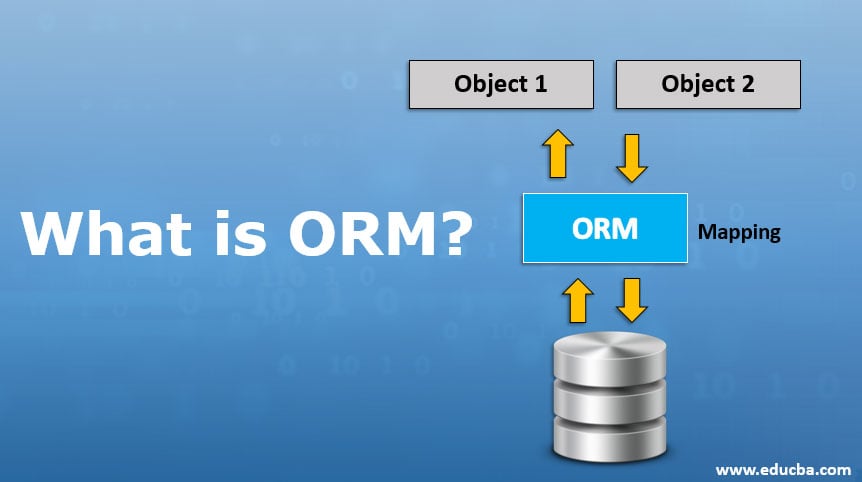
Introduction to ORM?
ORM stands for object-relational mapping, where objects are used to connect the programming language on to the database systems, with the facility to work SQL and object-oriented programming concepts. It is feasible for ORM to be implemented on any type of database management system where object mapping to the table can be achieved in the virtual system. There are many types of ORM languages like Django ORM, Dapper ORM, JOOQ ORM, SQL Alchemy, etc.
How ORM Works?
It operates on the objects. So the whole methodology followed by ORMs is dependent on the object-oriented paradigm. ORMs generate objects which map to tables in the database virtually. Once these objects are up, then coders can easily work to retrieve, manipulate or delete any field from the table without paying much attention to language specifically. It supports writing complex long SQL queries in a simpler way. It uses libraries to comprehend the code we are writing in the form of objects and then map it onto the database.
Suppose one is using to link python application with oracle database. In that case, the developer will have to choose the most relevant ORM as per the business requirements. This can be well understood by the diagram below:
Common Languages Between ORMs and OOPs
Some common ORMs and related OOPs language are:
- Hibernate: JAVA
- Django ORM: Django
- SQL Alchemy: Flask
- Microsoft Entity Framework: .NET framework
- Dapper ORM: C#
- JAVA Persistence API: JAVA
- NHibernate: .NET framework
- JOOQ ORM: JAVA
- Doctrine: PHP
This list is big as the number of application programming languages is increasing day by day.
Features
Some of the key features are as follows:
- It makes the application independent of the database management system being used in the backend, and so you can write a generic query. In case of migrating to another database, it becomes fairly a good deal to have ORM implemented in the project.
- Hassles of coders are reduced to learn SQL syntaxes separately for whichever database being used to support the application. Coders can shift their focus on optimizing the code and improving performance rather than dealing with connectivity issues.
- All small or big changes can be carried out via ORM, so there are no such restrictions when we deal with data. For example, JDBC comes with a lot of restrictions on extracting a result-set, process it and then commit it back to the database. This is not the case with ORMs. Even a single cell in the database can be retrieved, changed and saved back.
- The connection becomes robust, secure as there will be less intervention in code. It will handle all the necessary configurations required to map application programming language with the database’s query language since there will be lesser intervention promoting secure application as a whole.
- There is a fairly large deal of ORMs present in the market as per the application language used. One can choose easily as per business requirements.
- There is an attached disadvantage in using ORM as well. That is when the database is in legacy file systems and disarranged. It becomes a task to arrange a whole lot of data and then map this with ORM. It is thereby suggested to use ORM when the back end is fairly managed.
Advantages
Some of the highlights of ORM are listed below:
- No need to learn a database query language.
- It propagates the idea of data abstraction, thus improving data security.
- Instead of storing big procedures in pl/SQL in the backend, these can be saved in the frontend. It improves flexibility to make changes.
- If there are many relations like 1: m, n: m and lesser 1:1 in database structure, then ORM works well.
- It reduces the hassles for coders by reducing the database query part handling.
- Queries via ORM can be written irrespective of whatever database one is using in the back end. This provides a lot of flexibility to the coder. This is one of the biggest advantages offered by ORMs.
- These are available for any object-oriented language, so it is not only specific to one language.
Examples to Implement ORM
The below code snippet explains how ORM is used to map SQL statements when we are implementing it.
Example #1
Query to print all the newspapers by Times of India
Code:
Newspapers_by_TOI = Newspaper.objects.filter(publisher="TOI")
for Newspaper in Newspapers_by_TOI:
print(Newspapers)Here when We Use the Command: “anything.object.filter” This command will be used to retrieve the values of the field for the corresponding table. For example, over here, the publisher value is “TOI”, then the query should have been able to retrieve all details from the table “Newspapers”. The name of this object is given as “Newspapers by TOI”.
Example #2
Query to create a new newspaper in the database
Code:
Newspapers.object.create(publisher="TOI",name="19th dec 2019 TOI Newspaper")Here when We Use the Command: “anything.object.create” This command will be used to objectify the fields. For example, over here, publisher and name would have been stored in table “Newspapers” in the field “publisher” and “name”.
Conclusion
ORM is recommended to be used in small to mid-sized projects to reduce the impedance mismatch. This can be included wherever required as per the business requirements. There are some specific for particular front-end languages only like hibernate is used in combination with JAVA. Hence It is chosen on based on application programming technology which needs to be mapped with any database. This has reduced the efforts and improved the efficiency of coders as they can focus more on the core logic without much attention to be paid to database query language.
Recommended Articles
This is a guide to What is ORM? Here we discuss the Working of ORM and the advantages, features, and example to implement ORM. You can also go through our other related articles to learn more –


